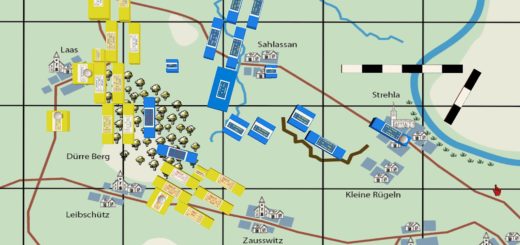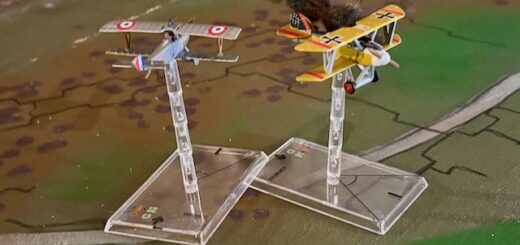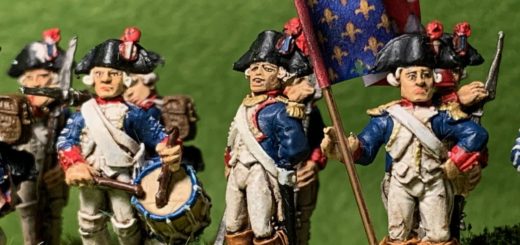VLB question and answers
Here I will put questions for Ned and Peter. Most recent messages are on top.
On command disruption and movement of commanders
From: Peter Dennis <magie.h@ntlworld.com></magie.h@ntlworld.com>
Subject: RE: VLB stuff
Date: February 20, 2012 11:43:16 AM GMT+01:00
Good luck with the game!
The VLB idea was conceived before decent computers were available, and your
program could make a massive difference to the ‘playability’ of the game.
What scale figures are you using for the trial game?
P
—–Original Message—–
Sent: 20 February 2012 10:28
To: Peter Dennis
Subject: Re: VLB stuff
Hi Peter,
thank you for your hints.
Commanders: in our case they are standalone from Division level up in the
chain, there is no rule foreseen regarding losses of Brigade commanders.
What I put in the code, if you agree, is:
– a disruption time which add delays to all messages passing by the commands
affected. This value is decreased by the passage of time and eventually goes
to 0, since control is regained gradually:
– also brigade commanders can be casualties. I don’t know whether the
probability for division and corp commanders applies here, since they are
not trying to lead the brigade in a special effort, like foreseen for
division and corps commanders.
The probability might be given simply by the percentage of casualties in a
bound.
– division commanders loss causes a 30 minute disruption, while for corps
this is increased to 40.
I don’t know whether a Cinc might be risked to lead an assault. in this case
a 120-180 minutes might be considered, since this is really a major problem.
– a simple model that can be implemented to take into account for moving
commands, high level commanders and brigades/batteries. I have the following
in mind:
– moving commands cause a shift in their time of receipt of their
messages.
– the time shift is proportional to their speed. A 10-minute bound
causes on a column moving on
road a shift of about 5 minutes (half the speed of a
staff/courier). This means also that moving
division and corps commanders have to stop in order to receive an
order, because their messages
are delayed by 10 minutes in a 10-minute bound.
This model reflect the difficulty of finding a moving command, the
best example is of a unit
moving away from a command, you get exactly the time delay I
mentioned for a courier trying
to reach the unit.
These calculations are practically impossible to do in a paper and pencil
game while they are simple using the program, since I record:
– current time and time to next event
– program has a queue containing all events, ordered by time. The queue is
reordered every time a new event is generated, message, melee end etc.
– unit formation and speed
– whether units have a movement or defence order.
– chain of command, each point in the chain is a commander, and leaves are
usually brigades and batteries.
Each element in the chain has associated a disruption time.
Tonight we will play our first game in the club: here are the Battle
rosters, to give you an idea of the size. I will let you know how we
managed.
Cheers Stefano
Maresciallo_Ney ( ney )
type: command quality: cmd with: 0 command post
frontage: [ 0 m ] 0 cm
VII_Corpo_Reynier ( rey )
type: command quality: cmd with: 0 command post
frontage: [ 0 m ] 0 cm
Divisione_Guilleminot ( gui )
type: command quality: cmd with: 0 command post
frontage: [ 0 m ] 0 cm
Batteria_Artiglieria_Leggera_Guilleminot_1 ( aguy1 )
type: lightArtillery quality: average with: 4 sections (2-gun)
frontage: [ 160 m ] 4 cm
Brigata_Guilleminot_1 ( fguy1 )
type: infantry quality: average with: 8 half-battalions
frontage: [ 640 m ] 16 cm CV: 64
Brigata_Guilleminot_2 ( fguy2 )
type: infantry quality: average with: 8 half-battalions
frontage: [ 640 m ] 16 cm CV: 64
Divisione_Durutte ( dur )
type: command quality: cmd with: 0 command post
frontage: [ 0 m ] 0 cm
Batteria_Artiglieria_Leggera_Durutte_1 ( adur1 )
type: lightArtillery quality: average with: 4 sections (2-gun)
frontage: [ 160 m ] 4 cm
Brigata_Durutte_1 ( fdur1 )
type: infantry quality: average with: 8 half-battalions
frontage: [ 640 m ] 16 cm CV: 64
Brigata_Durutte_2 ( fdur2 )
type: infantry quality: average with: 8 half-battalions
frontage: [ 640 m ] 16 cm CV: 64
Divisione_v_Zeschau ( zes )
type: command quality: cmd with: 0 command post
frontage: [ 0 m ] 0 cm
Batteria_Artiglieria_Leggera_Zeschau_1 ( azes1 )
type: lightArtillery quality: average with: 4 sections (2-gun)
frontage: [ 160 m ] 4 cm
Batteria_Artiglieria_Leggera_Zeschau_2 ( azes2 )
type: lightArtillery quality: average with: 4 sections (2-gun)
frontage: [ 160 m ] 4 cm
Brigata_Zeschau_1 ( fzes1 )
type: infantry quality: average with: 8 half-battalions
frontage: [ 640 m ] 16 cm CV: 64
Brigata_Zeschau_2 ( fzes2 )
type: infantry quality: average with: 8 half-battalions
frontage: [ 640 m ] 16 cm CV: 64
Artiglieria_Reynier ( are )
type: command quality: cmd with: 0 command post
frontage: [ 0 m ] 0 cm
Batteria_Artiglieria_Pesante_Reynier_1 ( are1 )
type: heavyArtillery quality: average with: 4 sections (2-gun)
frontage: [ 160 m ] 4 cm
Batteria_Artiglieria_Pesante_Reynier_2 ( are2 )
type: heavyArtillery quality: average with: 4 sections (2-gun)
frontage: [ 160 m ] 4 cm
Batteria_Artiglieria_Pesante_Reynier_3 ( are3 )
type: heavyArtillery quality: average with: 4 sections (2-gun)
frontage: [ 160 m ] 4 cm
Cavalleria_Reynier ( cre )
type: command quality: cmd with: 0 command post
frontage: [ 0 m ] 0 cm
Batteria_Artiglieria_Cavallo_Reynier_1 ( hre1 )
type: horseArtillery quality: average with: 3 sections (2-gun)
frontage: [ 120 m ] 3 cm
Batteria_Artiglieria_Cavallo_Reynier_2 ( hre2 )
type: horseArtillery quality: average with: 3 sections (2-gun)
frontage: [ 120 m ] 3 cm
Brigata_Cavelleria_Reynier ( cre1 )
type: lightCavalry quality: average with: 8 squadrons
frontage: [ 640 m ] 16 cm CV: 56
V_Corpo_Cavalleria_Pajol ( paj )
type: command quality: cmd with: 0 command post
frontage: [ 0 m ] 0 cm
Divisione_Piret ( pir )
type: command quality: cmd with: 0 command post
frontage: [ 0 m ] 0 cm
Artiglieri_Cavallo_Piret ( hpir )
type: horseArtillery quality: average with: 3 sections (2-gun)
frontage: [ 120 m ] 3 cm
Brigata_Cavelleria_Piret_1 ( pir1 )
type: lightCavalry quality: average with: 8 squadrons
frontage: [ 640 m ] 16 cm CV: 56
Brigata_Cavelleria_Piret_2 ( pir2 )
type: lightCavalry quality: average with: 8 squadrons
frontage: [ 640 m ] 16 cm CV: 56
Divisione_L_Heritier ( lhe )
type: command quality: cmd with: 0 command post
frontage: [ 0 m ] 0 cm
Artiglieri_Cavallo_L_Heritier ( hlhe )
type: horseArtillery quality: average with: 3 sections (2-gun)
frontage: [ 120 m ] 3 cm
Brigata_Cavelleria_L_Heritier_1 ( lhe1 )
type: heavyCavalry quality: average with: 8 squadrons
frontage: [ 640 m ] 16 cm CV: 64
Brigata_Cavelleria_L_Heritier_2 ( lhe2 )
type: heavyCavalry quality: average with: 8 squadrons
frontage: [ 640 m ] 16 cm CV: 64
Divisione_Milhaud ( mil )
type: command quality: cmd with: 0 command post
frontage: [ 0 m ] 0 cm
Artiglieri_Cavallo_Milhaud ( hmil )
type: horseArtillery quality: average with: 3 sections (2-gun)
frontage: [ 120 m ] 3 cm
Brigata_Cavelleria_Milhaud_1 ( mil1 )
type: heavyCavalry quality: average with: 8 squadrons
frontage: [ 640 m ] 16 cm CV: 64
Brigata_Cavelleria_Milhaud_2 ( mil2 )
type: heavyCavalry quality: average with: 8 squadrons
frontage: [ 640 m ] 16 cm CV: 64
Command win
Corpo_Wintzingerode ( win )
Corpo_Wintzingerode ( win )
type: command quality: cmd with: 0 command post
frontage: [ 0 m ] 0 cm
Avanguardia ( ava )
type: command quality: cmd with: 0 command post
frontage: [ 0 m ] 0 cm
Divisione_Worontzow ( von )
type: command quality: cmd with: 0 command post
frontage: [ 0 m ] 0 cm
Batteria_6_Horse ( 6h )
type: lightArtillery quality: average with: 3 sections (2-gun)
frontage: [ 120 m ] 3 cm
Jaeger ( ja )
type: infantry quality: average with: 10 half-battalions
frontage: [ 800 m ] 20 cm CV: 100
Divisione_O_Rourke ( oro )
type: command quality: cmd with: 0 command post
frontage: [ 0 m ] 0 cm
Batteria_6_O_Rourke ( ao )
type: lightArtillery quality: average with: 3 sections (2-gun)
frontage: [ 120 m ] 3 cm
Cavalleria_O_Rourke ( b1o )
type: lightCavalry quality: average with: 14 squadrons
frontage: [ 1120 m ] 28 cm CV: 98
Cosacchi_1_O_Rourke ( b2o )
type: lightCavalry quality: poor with: 8 squadrons
frontage: [ 640 m ] 16 cm CV: 40
Cosacchi_2_O_Rourke ( b3o )
type: lightCavalry quality: poor with: 8 squadrons
frontage: [ 640 m ] 16 cm CV: 40
Cosacchi_3_O_Rourke ( b4o )
type: lightCavalry quality: poor with: 8 squadrons
frontage: [ 640 m ] 16 cm CV: 40
Divisione_Laptiev ( lap )
type: command quality: cmd with: 0 command post
frontage: [ 0 m ] 0 cm
Batteria_6_Laptiev ( al )
type: lightArtillery quality: average with: 3 sections (2-gun)
frontage: [ 120 m ] 3 cm
Batteria_12_Laptiev ( 12l )
type: heavyArtillery quality: average with: 3 sections (2-gun)
frontage: [ 120 m ] 3 cm
Linea_Laptiev ( lnl )
type: infantry quality: average with: 12 half-battalions
frontage: [ 960 m ] 24 cm CV: 96
Divisione_Vuich ( vui )
type: command quality: cmd with: 0 command post
frontage: [ 0 m ] 0 cm
Batteria_6_Vuich ( av )
type: lightArtillery quality: average with: 3 sections (2-gun)
frontage: [ 120 m ] 3 cm
Brigata_1_Vuich ( b1v )
type: infantry quality: average with: 8 half-battalions
frontage: [ 640 m ] 16 cm CV: 64
Brigata_2_Vuich ( b2v )
type: infantry quality: average with: 12 half-battalions
frontage: [ 960 m ] 24 cm CV: 96
Divisione_Harpe ( har )
type: command quality: cmd with: 0 command post
frontage: [ 0 m ] 0 cm
Batteria_12_Harpe ( a1h )
type: heavyArtillery quality: average with: 3 sections (2-gun)
frontage: [ 120 m ] 3 cm
Batteria_12_Harpe ( a2h )
type: heavyArtillery quality: average with: 3 sections (2-gun)
frontage: [ 120 m ] 3 cm
Linea_Harpe ( lnh )
type: infantry quality: average with: 14 half-battalions
frontage: [ 1120 m ] 28 cm CV: 140
Manteuffel ( man )
type: command quality: cmd with: 0 command post
frontage: [ 0 m ] 0 cm
Batteria_6_Horse_Manteuffel ( am )
type: lightArtillery quality: average with: 3 sections (2-gun)
frontage: [ 120 m ] 3 cm
Cavalleria_Manteuffel ( cm )
type: lightCavalry quality: average with: 14 squadrons
frontage: [ 1120 m ] 28 cm CV: 112
Pahlen ( pah )
type: command quality: cmd with: 0 command post
frontage: [ 0 m ] 0 cm
Batteria_6_Horse_Pahlen ( ap )
type: lightArtillery quality: average with: 3 sections (2-gun)
frontage: [ 120 m ] 3 cm
Cavalleria_Pahlen ( cp )
type: lightCavalry quality: average with: 12 squadrons
frontage: [ 960 m ] 24 cm CV: 96
Zargr ( zar )
type: command quality: cmd with: 0 command post
frontage: [ 0 m ] 0 cm
Cavalleria_Zargr ( cz )
type: lightCavalry quality: average with: 11 squadrons
frontage: [ 880 m ] 22 cm CV: 88
Illow ( ill )
type: command quality: cmd with: 0 command post
frontage: [ 0 m ] 0 cm
Cosacchi_Illow ( ci )
type: cossacks quality: average with: 20 squadrons
frontage: [ 1600 m ] 40 cm CV: 100
From: Peter Dennis <magie.h@ntlworld.com></magie.h@ntlworld.com>
Subject: RE: VLB stuff PS
Date: February 18, 2012 10:31:23 AM GMT+01:00
I meant to add that a commander can write an order in any place he only has
to write on a piece of paper with a pencil. Orders were often sent in
duplicate – the same order sent twice – in case the messenger failed to
get through.
I wanted to make the game as frustrating and difficult as a real commander
would find it. I hope you have retained the ban on the word ‘IF’ – very
important!
P
From: Peter Dennis <magie.h@ntlworld.com></magie.h@ntlworld.com>
Subject: RE: VLB stuff
Date: February 18, 2012 10:26:20 AM GMT+01:00
Hi Stefano
When you say ‘Commander’ I wonder what level you mean? I haven’t read the
rules for many years! I think 20 minutes to organise A new Brigade
commander from the Brigade staff would be OK – I guess they would know who
was ‘next in line’ for the job. This would only have an effect when new
movement orders came in, really. If the Brigade was in combat, the Brigade
commander wouldn’t have much of a command role as the company officers
handled all that.
When a Division or Corps commander is lost the situation is much more
serious as the link in the chain of command is broken and messages passing
through the chain of command would be delayed say for 30 minutes at Division
and 40 minutes at Corps level. Of course, once the new commander is in place
the chain is repaired and messages pass in the normal time.
On the question of where a commander is – especially in the case of a corps
or army commander – If you imagine the battlefield situation where there is
much confusion and smoke and moving units. Sending a message to the
commander is very difficult if you don’t know where he is. Army commanders
set up a command post in a fixed spot and messengers went there. If the
commander moved to a different position, perhaps to intervene in some
situation, messengers could not know that and would go to the fixed command
post first then be redirected to where the post staff thought the Commander
was – much confusion and delay!
I hope that helps
—–Original Message—–
Sent: 18 February 2012 08:34
To: Peter Dennis
Subject: Re: VLB stuff
Hi Peter,
…
Now questions! I may start with a letter I put on the Yahoo page regarding
command chain disruption and transmission of orders.
Starting from what is written in the napoleonic booklet I have started
coding into my program the effect of commanders joining into a brigade
combat, and I have found by looking at both the napoleonic and the acw book
that the chance of losing a commander has been evaluated roughly as:
10%+number of minutes in combat.
My current problem now is what to do when a commander is lost.
I have the simple idea that this would cause a disruption in the command
chain, but for how long? I guess this would be rather subjective, depending
on who was actually lost.
I need in any case to put some algorithm in my code and I thought that a
disruption for example of 30 minutes could be considered.
This number would add up to the order transmission times along a command
chain going through that command.
How many minutes would you put as a sound number?
My second question concerns the writing of orders. In the napoleonic booklet
some changes of situation prompt the movement of a commander.
Does this mean that normally commands are stopped in place?
Do commands need to be in a known place in order to receive or pass an
order?
Do they need to be not moving in order to write an order?
What was the actual practice in the napoleonic era?
Thank you and
Happy gaming
Stefano



